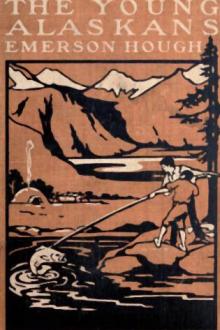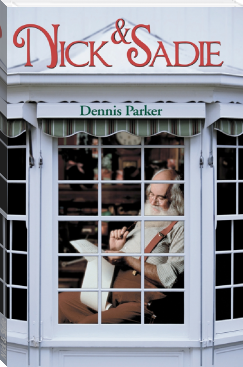The Lighthouse, R. M. Ballantyne [well read books TXT] 📗

- Author: R. M. Ballantyne
Book online «The Lighthouse, R. M. Ballantyne [well read books TXT] 📗». Author R. M. Ballantyne
The operation being, perhaps, the most important of the season, and one requiring to be done with the utmost expedition, all hands were, on the day in which its erection was begun, gathered on the rock, besides ten additional men engaged for the purpose, and as many of the seamen from the Pharos and other vessels as could be spared. They amounted altogether to fifty-two in number.
About half-past eight o’clock in the morning a derrick, or mast, thirty feet high, was erected, and properly supported with guy-ropes for suspending the block for raising the first principal beam of the beacon, and a winch-machine was bolted down to the rock for working the purchase-tackle. The necessary blocks and tackle were likewise laid to hand and properly arranged. The men were severally allotted in squads to different stations; some were to bring the principal beams to hand, others were to work the tackles, while a third set had the charge of the iron stanchions, bolts, and wedges, so that the whole operation of raising the beams and fixing them to the rock might go forward in such a mariner that some provision might be made, in any stage of the work, for securing what had been accomplished, in case of an adverse change of weather.
The raising of the derrick was the signal for three hearty cheers, for this was a new era in the operations. Even that single spar, could it be preserved, would have been sufficient to have saved the workmen on that day when the Smeaton broke adrift and left them in such peril.
This was all, however, that could be accomplished that tide. Next day, the great beams, each fifty feet long, and about sixteen inches square, were towed to the rock about seven in the morning, and the work immediately commenced, although they had gone there so much too early in the tide that the men had to work a considerable time up to their middle in water. Each beam was raised by the tackle affixed to the derrick, until the end of it could be placed or “stepped” into the hole which had been previously prepared for its reception; then two of the great iron stanchions or supports were set into their respective holes on each side of the beam, and a rope passed round them to keep it from slipping, until it could be more permanently fixed.
This having been accomplished, the first beam became the means of raising the second, and when the first and second were fastened at the top, they formed a pair of shears by which the rest were more easily raised to their places. The heads of the beams were then fitted together and secured with ropes in a temporary manner, until the falling of the tide would permit the operations to be resumed.
Thus the work went on, each man labouring with all his might, until this important erection was completed.
The raising of the first beams took place on a Sunday. Indeed, during the progress of the works at the Bell Rock, the men were accustomed to work regularly on Sundays when possible; but it is right to say that it was not done in defiance of, or disregard to, God’s command to cease from labour on the Sabbath day, but because of the urgent need of a lighthouse on a rock which, unlighted, would be certain to wreck numerous vessels and destroy many lives in time to come, as it had done in time past. Delay in this matter might cause death and disaster, therefore it was deemed right to carry on the work on Sundays. (See note 1.)
An accident happened during the raising of the last large beam of the beacon, which, although alarming, fortunately caused no damage. Considering the nature of the work, it is amazing, and greatly to the credit of all engaged, that so few accidents occurred during the building of the lighthouse.
When they were in the act of hoisting the sixth and last log, and just about to cant it into its place, the iron hook of the principal purchase-block gave way, and the great beam, measuring fifty feet in length, fell upon the rock with a terrible crash; but although there were fifty-two men around the beacon at the time, not one was touched, and the beam itself received no damage worth mentioning.
Soon after the beacon had been set up, and partially secured to the rock, a severe gale sprang up, as if Ocean were impatient to test the handiwork of human engineers. Gales set in from the eastward, compelling the attending sloops to slip from their moorings, and run for the shelter of Arbroath and Saint Andrews, and raising a sea on the Bell Rock which was described as terrific, the spray rising more than thirty feet in the air above it.
In the midst of all this turmoil the beacon stood securely, and after the weather moderated, permitting the workmen once more to land, it was found that no damage had been done by the tremendous breaches of the sea over the rock.
That the power of the waves had indeed been very great, was evident from the effects observed on the rock itself, and on materials left there. Masses of rock upwards of a ton in weight had been cast up by the sea, and then, in their passage over the Bell Rock, had made deep and indelible ruts. An anchor of a ton weight, which had been lost on one side of the rock, was found to have been washed up and over it to the other side. Several large blocks of granite that had been landed and left on a ledge, were found to have been swept away like pebbles, and hurled into a hole at some distance; and the heavy hearth of the smith’s forge, with the ponderous anvil, had been washed from their places of supposed security.
From the time of the setting up of the beacon a new era in the work began. Some of the men were now enabled to remain on the rock all day, working at the lighthouse when the tide was low, and betaking themselves to the beacon when it rose, and leaving it at night; for there was much to do before this beacon could be made the habitable abode which it finally became; but it required the strictest attention to the state of the weather, in case of their being overtaken with a gale, which might prevent the possibility of their being taken off the rock.
At last the beacon was so far advanced and secured that it was deemed capable of withstanding any gale that might blow. As yet it was a great ungainly pile of logs, iron stanchions, and bracing-chains, without anything that could afford shelter to man from winds or waves, but with a platform laid from its cross-beams at a considerable height above high-water mark.
The works on the rock were in this state, when two memorable circumstances occurred in the Bell Rock annals, to which we shall devote a separate chapter.
Note 1. It was always arranged, however, to have public worship on Sundays when practicable. And this arrangement was held to during the continuance of the work. Indeed, the manner in which Mr Stevenson writes in regard to the conclusion of the day’s work at the beacon, which we have described, shows clearly that he felt himself to be acting in this matter in accordance with the spirit of our Saviour, who wrought many of His works of mercy on the Sabbath day. Mr Stevenson writes thus:—
“All hands having returned to their respective ships, they got a shift of dry clothes, and some refreshment. Being Sunday, they were afterwards convened by signal on board of the lighthouse yacht, when prayers were read, for every heart upon this occasion felt gladness, and every mind was disposed to be thankful for the happy and successful termination of the operations of this day.”
It is right to add that the men, although requested, were not constrained to work on Sundays. They were at liberty to decline if they chose. A few conscientiously refused at first, but were afterwards convinced of the necessity of working on all opportunities that offered, and agreed to do so.
James Dove, the blacksmith, had, for some time past, been watching the advancing of the beacon-works with some interest, and a good deal of impatience. He was tired of working so constantly up to the knees in water, and aspired to a drier and more elevated workshop.
One morning he was told by the foreman that orders had been given for him to remove his forge to the beacon, and this removal, this “flitting”, as he called it, was the first of the memorable events referred to in the last chapter.
“Hallo! Ruby, my boy,” cried the elated son of Vulcan, as he descended the companion ladder, “we’re goin’ to flit, lad. We’re about to rise in the world, so get up your bellows. It’s the last time we shall have to be bothered with them in the boat, I hope.”
“That’s well,” said Ruby, shouldering the unwieldy bellows; “they have worn my shoulders threadbare, and tried my patience almost beyond endurance.”
“Well, it’s all over now, lad,” rejoined the smith. “In future you shall have to blow up in the beacon yonder; so come along.”
“Come, Ruby, that ought to comfort the cockles o’ yer heart,” said O’Connor, who passed up the ladder as he spoke; “the smith won’t need to blow you up any more, av you’re to blow yourself up in the beacon in futur’. Arrah! there’s the bell again. Sorrow wan o’ me iver gits to slape, but I’m turned up immadiately to go an’ poke away at that rock—faix, it’s well named the Bell Rock, for it makes me like to bellow me lungs out wid vexation.”
“That pun is below contempt,” said Joe Dumsby, who came up at the moment.
“That’s yer sort, laddies; ye’re guid at ringing the changes on that head onyway,” cried Watt.
“I say, we’re gittin’ a belly-full of it,” observed Forsyth, with a rueful look. “I hope nobody’s goin’ to give us another!”
“It’ll create a rebellion,” said Bremner, “if ye go on like that.”
“It’ll bring my bellows down on the head o’ the next man that speaks!” cried Ruby, with indignation.
“Don’t you hear the bell, there?” cried the foreman down the hatchway.
There was a burst of laughter at this unconscious continuation of the joke, and the men sprang up the ladder,—down the side, and into the boats, which were soon racing towards the rock.
The day, though not sunny, was calm and agreeable, nevertheless the landing at the rock was not easily accomplished, owing to the swell caused by a recent gale. After one or two narrow escapes of a ducking, however, the crews landed, and the bellows, instead of being conveyed to their usual place at the forge, were laid at the foot of the beacon.
The carriage of these bellows to and fro almost daily had been a subject of great annoyance to the men, owing to their being so much in the way, and so unmanageably bulky, yet so essential to the progress of the works, that they did not dare to leave them on the rock, lest they should be washed





Comments (0)